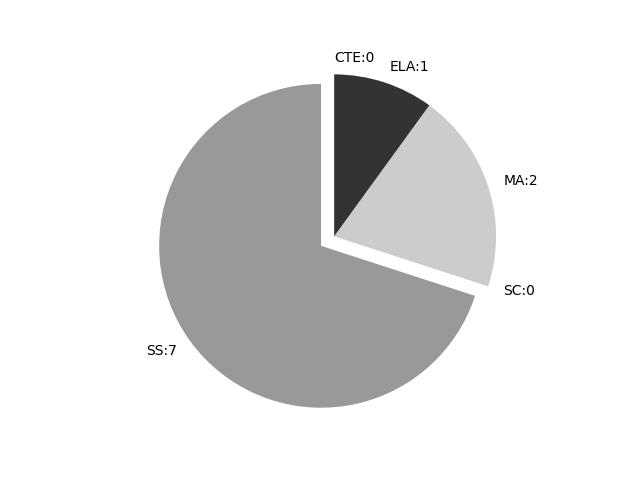GIStandards
https://trbaker.github.io/GIStandards/
A machine analysis of geospatial language in US K-12 state curriculum standards
DC
Report date: 2021-07-08
The frequency of all keywords found in this state's standards: 10
Comparable state score: 0.269 (median: .303, SD: .324)
The frequency above is the sum of all keywords found in all of this state's four core academic standards and the state's CTE/career standards. This total count is broken down by keyword and discipline area below.
On this site, 'comparable scores' are calculated as: keywords found divided by total words in the standards document(s) - multiplied by 100,000. The comparable scores attempt to normalize data, accounting for very different sizes of curriculum guidance documentation.
Frequencies by keyword or phrase:Frequencies by discipline area: - SS: 7
(Comp: 0.679) - SC: 0
(Comp: 0.0) - MA: 2
(Comp: 0.188) - ELA: 1
(Comp: 0.18) - CTE: 0
(Comp: None)
Support files: Examples of keyword use by discipline area (and document): - ELA
- ADA_CC_ELAStandards.pdf, page:27, position:4345
to better understand each of the words.6.Acquire and use accurately grade-appropriate conversational, general academic, and domain- speciÞc words and phrases, including those that signal spatial and temporal relationships (e.g., After dinner
- MA
- ADA_CC_MathStandards.pdf, page:1, position:565
greater focus and coherenceMathematics experiences in early childhood settings should concentrate on(1) number (which includes whole number, operations, and relations) and (2) geometry, spatial relations, and measurement, with more mathema - ADA_CC_MathStandards.pdf, page:8, position:309
combined sets, or counting the number of objects that remain in a set after some are taken away.Students describe their physical world using geometric ideas (e.g., shape, orientation, spatial relations) and vocabulary. They identify, nam
- SS
- DCPS-horiz-soc_studies.pdf, page:1, position:3622
Research, Evidence, and Point of View......................29Grade 6 Ñ World Geography and Cultures . . . . . . . . . . . . . . . . . . . . . . . . . . . . . . . 30The World in Spatial Terms .........................................30 - DCPS-horiz-soc_studies.pdf, page:15, position:702
reasoning, reflection, and research skills:CHRONOLOGY AND CAUSE AND EFFECT1.Students place key events and people of the historical era they are studying in a chronological sequence and within a spatial context.2.Students correctly apply terms related - DCPS-horiz-soc_studies.pdf, page:31, position:1250
and obtain answers from a variety of sources, such as books, atlases, and other written materials; statistical sourcematerial; fieldwork and interviews; remote sensing; word processing; and GIS. Reach conclusions and give oral, written, graphi - DCPS-horiz-soc_studies.pdf, page:31, position:382
acquire and process information about people, places, and environments. 1.Demonstrate that, in attempting to represent the round Earth on flat paper, all maps distort. 2.Explain that maps contain spatial elements of point, line, area, and volume.3.Locat - DCPS-horiz-soc_studies.pdf, page:44, position:2775
(e.g.,Henry ClayÕs American System). (G, E)4.List and describe the reasons for the wave of immigration from Northern Europe to the United States, and describe the growth in the num-ber, size, and spatial arrangements of cities (e.g., Irish immigrants an - DCPS-horiz-soc_studies.pdf, page:79, position:1107
in numerous states (e.g., the process of referendums and recall elections).6.Analyze trends in voter turnout; the causes and effects of reapportionment and redistricting, with special attention to spatial districting andthe rights of minorities; and the - DCPS-horiz-soc_studies.pdf, page:91, position:2326
to entrepreneurs in a market economy.9.Describe the functions of financial markets.10.Describe the economic principles that guide the location of agricultural production and industry and the spatial distribution of transporta-tion and retail facili
On this site, 'comparable scores' are calculated as: keywords found divided by total words in the standards document(s) - multiplied by 100,000. The comparable scores attempt to normalize data, accounting for very different sizes of curriculum guidance documentation.
(Comp: 0.679)
(Comp: 0.0)
(Comp: 0.188)
(Comp: 0.18)
(Comp: None)
- ADA_CC_ELAStandards.pdf, page:27, position:4345
to better understand each of the words.6.Acquire and use accurately grade-appropriate conversational, general academic, and domain- speciÞc words and phrases, including those that signal spatial and temporal relationships (e.g., After dinner
- ADA_CC_MathStandards.pdf, page:1, position:565
greater focus and coherenceMathematics experiences in early childhood settings should concentrate on(1) number (which includes whole number, operations, and relations) and (2) geometry, spatial relations, and measurement, with more mathema - ADA_CC_MathStandards.pdf, page:8, position:309
combined sets, or counting the number of objects that remain in a set after some are taken away.Students describe their physical world using geometric ideas (e.g., shape, orientation, spatial relations) and vocabulary. They identify, nam
- DCPS-horiz-soc_studies.pdf, page:1, position:3622
Research, Evidence, and Point of View......................29Grade 6 Ñ World Geography and Cultures . . . . . . . . . . . . . . . . . . . . . . . . . . . . . . . 30The World in Spatial Terms .........................................30 - DCPS-horiz-soc_studies.pdf, page:15, position:702
reasoning, reflection, and research skills:CHRONOLOGY AND CAUSE AND EFFECT1.Students place key events and people of the historical era they are studying in a chronological sequence and within a spatial context.2.Students correctly apply terms related - DCPS-horiz-soc_studies.pdf, page:31, position:1250
and obtain answers from a variety of sources, such as books, atlases, and other written materials; statistical sourcematerial; fieldwork and interviews; remote sensing; word processing; and GIS. Reach conclusions and give oral, written, graphi - DCPS-horiz-soc_studies.pdf, page:31, position:382
acquire and process information about people, places, and environments. 1.Demonstrate that, in attempting to represent the round Earth on flat paper, all maps distort. 2.Explain that maps contain spatial elements of point, line, area, and volume.3.Locat - DCPS-horiz-soc_studies.pdf, page:44, position:2775
(e.g.,Henry ClayÕs American System). (G, E)4.List and describe the reasons for the wave of immigration from Northern Europe to the United States, and describe the growth in the num-ber, size, and spatial arrangements of cities (e.g., Irish immigrants an - DCPS-horiz-soc_studies.pdf, page:79, position:1107
in numerous states (e.g., the process of referendums and recall elections).6.Analyze trends in voter turnout; the causes and effects of reapportionment and redistricting, with special attention to spatial districting andthe rights of minorities; and the - DCPS-horiz-soc_studies.pdf, page:91, position:2326
to entrepreneurs in a market economy.9.Describe the functions of financial markets.10.Describe the economic principles that guide the location of agricultural production and industry and the spatial distribution of transporta-tion and retail facili
